Training your pecs is a fundamental part of growing and trimming your chest. Whether you are a workout enthusiast or devising your first training plan, the workouts below will help you meet your fitness goals.
floor fly (with barbell)
_Chest_360.gif)
1. Start by lying flat on your back on the floor. Your feet should be flat on the ground and your knees bent at a 90-degree angle.
2. Hold a barbell with both hands, using an overhand grip. Your hands should be slightly wider than shoulder-width apart.
3. Extend your arms straight up towards the ceiling, holding the barbell directly above your chest. This is your starting position.
4. Slowly lower the barbell in an arc-like motion towards the floor. Keep your elbows slightly bent and your arms parallel to the floor as you do this.
5. Continue lowering the barbell until your upper arms are in line with your body and touch the floor.
6. Pause for a moment, then reverse the movement, lifting the barbell back up in an arc-like motion until it's directly above your chest again.
7. Repeat this movement for the desired number of repetitions.
Remember to keep your movements slow and controlled, focusing on the contraction of your pecs. Also, ensure your back remains flat on the floor throughout the exercise to avoid injury.
barbell wide reverse grip bench press
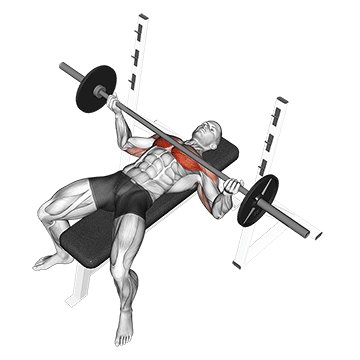
1. Start by lying flat on a bench, feet firmly on the ground. Make sure your back is in a neutral position and not arched.
2. Hold the barbell with a wide reverse grip, meaning your palms should be facing towards you. The grip should be wider than shoulder-width apart.
3. Lift the barbell off the rack or have a spotter help you. Hold it straight over your chest with your arms fully extended.
4. Inhale and slowly lower the barbell towards your chest. Keep your elbows close to your body to protect your shoulders.
5. Once the barbell is an inch from your chest, exhale and push the barbell back to the starting position. Make sure to use your chest muscles to push up the barbell.
6. Repeat this movement for your desired number of repetitions.
7. When you're done, carefully re-rack the barbell or have your spotter help you.
Remember to always use a weight that's challenging but manageable for you, and always maintain proper form to avoid injury.
barbell wide bench press
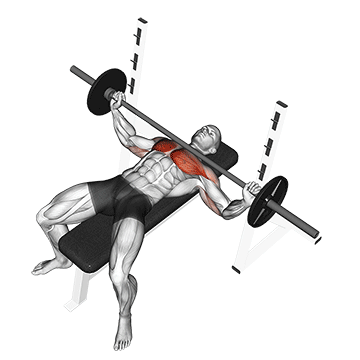
1. Start by loading your desired weight onto the barbell. Ensure the weight is evenly distributed on both sides.
2. Position yourself on the bench with your feet flat on the ground. Your back should be flat against the bench.
3. Reach up and grasp the barbell with a wide grip. Your hands should be wider than shoulder-width apart.
4. Lift the barbell off the rack or have a spotter help you. Hold it straight over your chest with your arms fully extended.
5. Inhale and slowly lower the barbell to your chest. Keep your elbows at a 90-degree angle as you bring the barbell down.
6. Once the barbell touches your chest, exhale and push the barbell back up to the starting position. Make sure to use your chest muscles to push the barbell up.
7. Repeat this movement for your desired number of repetitions.
8. When you're done, carefully re-rack the barbell or have your spotter help you.
Remember to always keep your movements controlled and steady. Don't let the barbell bounce off your chest, and don't lock your elbows at the top of the movement.
barbell reverse grip incline bench press
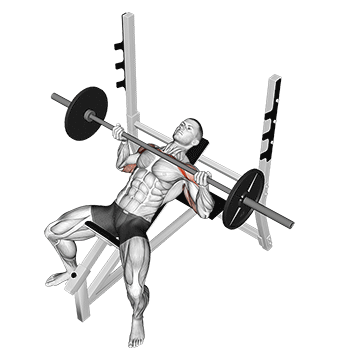
1. Start by setting up your incline bench at a 45-degree angle.
2. Load your desired weight onto the barbell and place it on the rack above the bench.
3. Sit down on the bench and position your feet flat on the ground for stability.
4. Reach up and grab the barbell with a reverse grip, meaning your palms should be facing towards you. Your hands should be slightly wider than shoulder-width apart.
5. Unrack the barbell and hold it straight over your chest with your arms fully extended. This is your starting position.
6. Slowly lower the barbell towards your chest while keeping your elbows close to your body. Ensure that the barbell remains directly over your chest.
7. Once the barbell is an inch or two from your chest, push it back up to the starting position. Make sure to exhale as you push the barbell up.
8. Repeat this movement for your desired number of repetitions.
9. After completing your set, carefully re-rack the barbell.
Remember to always use a spotter when performing this exercise to ensure safety. Also, avoid locking your elbows when you push the barbell up, and keep your back pressed against the bench throughout the exercise.
barbell reverse grip decline bench press
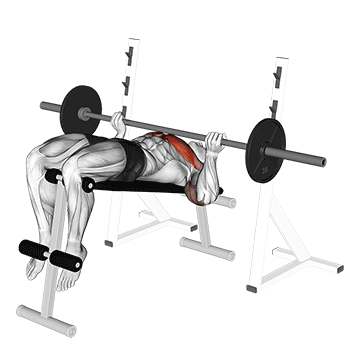
1. Start by setting up your decline bench at an angle of about 15-30 degrees.
2. Load your desired weight onto the barbell and place it on the rack above the decline bench.
3. Lie down on the decline bench with your feet securely locked under the foot pads.
4. Reach up and grab the barbell with a reverse grip, meaning your palms should be facing towards you. Your hands should be slightly wider than shoulder-width apart.
5. Lift the barbell off the rack and hold it straight over your chest with your arms fully extended. This is your starting position.
6. Slowly lower the barbell towards your chest while keeping your elbows close to your body. Ensure that you maintain control of the barbell at all times.
7. Once the barbell is an inch or two from your chest, push it back up to the starting position. Make sure to exhale as you push the barbell up.
8. Repeat this movement for your desired number of repetitions.
9. After completing your set, carefully re-rack the barbell.
Remember to always use a spotter when performing this exercise to ensure safety. The barbell reverse grip decline bench press is a challenging exercise that targets the lower pecs, so start with a lighter weight and gradually increase as you become more comfortable with the movement.
barbell incline bench press
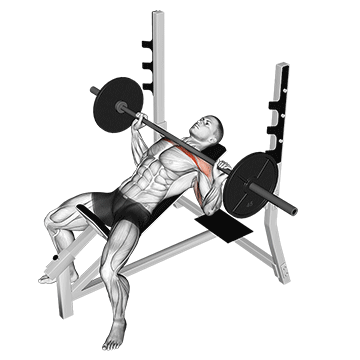
To perform the barbell incline bench press, follow these steps:
1. Set up your incline bench at a 45-degree angle. If you're new to this exercise, you may want to start with a lower angle to get used to the movement.
2. Load your barbell with the desired weight. Always ensure the weight is evenly distributed on both sides.
3. Sit down on the bench with your feet flat on the floor. Lean back and grab the barbell with an overhand grip. Your hands should be slightly wider than shoulder-width apart.
4. Lift the barbell off the rack and hold it straight over your chest with your arms fully extended. This is your starting position.
5. Inhale and slowly lower the barbell to your chest. Keep your elbows at a 90-degree angle as you bring the barbell down.
6. Pause for a moment at the bottom of the movement, then exhale as you push the barbell back up to the starting position. Make sure to use your chest muscles to push the barbell up.
7. Repeat for the desired number of reps. When you're done, carefully re-rack the barbell.
Remember to keep your back pressed against the bench throughout the exercise. Avoid lifting your hips off the bench as this can lead to injury. Always start with a lighter weight to perfect your form before moving on to heavier weights.
barbell guillotine bench press
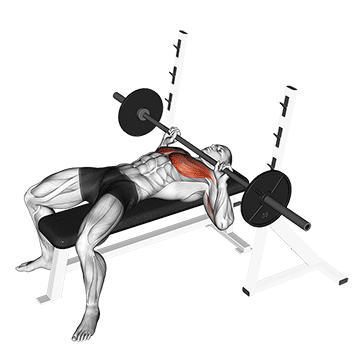
To perform the barbell guillotine bench press, follow these steps:
1. Start by lying flat on a bench, feet firmly on the ground. Make sure your back is in a neutral position and not arched.
2. Reach up and grab the barbell with an overhand grip. Your hands should be slightly wider than shoulder-width apart.
3. Unrack the barbell and hold it straight over your chest with your arms fully extended. This is your starting position.
4. Slowly lower the barbell towards your neck, keeping your elbows flared out to the sides. The bar should be moving in a straight line and should come close to touching your neck. This is why it's called a "guillotine" press.
5. Pause for a moment at the bottom of the movement, then push the barbell back up to the starting position. Make sure to keep your wrists straight and your elbows slightly bent at the top of the movement to keep tension on your pecs.
6. Repeat for the desired number of reps.
Remember to always use a spotter when performing this exercise to ensure safety. The barbell guillotine bench press is a great exercise for targeting the pecs, but it should be done with caution due to the barbell's proximity to the neck.
barbell front raise and pullover
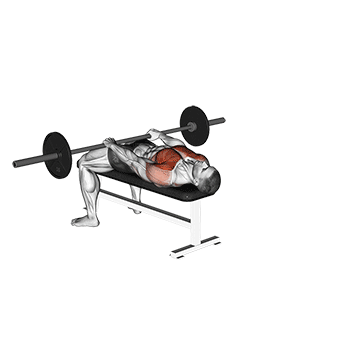
1. Start by standing upright with your feet shoulder-width apart. Hold a barbell with an overhand grip, hands slightly wider than shoulder-width apart. This is your starting position.
2. Slowly raise the barbell up in front of you, keeping your arms extended. Continue to lift until your arms are parallel to the floor and the barbell is at shoulder height.
3. Pause for a moment at the top of the movement, then slowly lower the barbell back down to the starting position.
4. Once the barbell is back at waist height, continue the movement by bending your elbows and pulling the barbell towards your chest.
5. From here, extend your arms and push the barbell up and over your head, keeping your arms slightly bent. This is the pullover part of the exercise.
6. Lower the barbell back down to chest height, then extend your arms to push the barbell back out in front of you, returning to the starting position.
7. That's one rep. Aim for 3 sets of 8-12 reps, depending on your strength and fitness level.
Remember to keep your back straight and your core engaged throughout the exercise. Also, ensure that the weight you're using is challenging but manageable. If it's too heavy, you risk straining your shoulders or back. If it's too light, you won't effectively work your pecs.
barbell decline wide-grip press
To perform the barbell decline wide-grip press, start by setting up your decline bench at an angle of about 15-30 degrees. Then, load your barbell with the desired weight and place it on the rack above the bench.
Lie down on the decline bench with your feet securely hooked under the foot pads. Reach up and grab the barbell with a wide grip, hands wider than shoulder-width apart. Your palms should be facing away from you.
Unrack the barbell and hold it straight over your chest with your arms fully extended. This is your starting position.
Inhale and slowly lower the barbell towards your chest. Keep your elbows flared out to the sides and ensure that the barbell is in line with your lower chest.
Pause for a moment when the barbell is just an inch above your chest, then exhale and push the barbell back up to the starting position. Use your chest muscles to push the weight, and make sure to keep your arms straight.
Repeat this movement for your desired number of repetitions. When you're done, carefully rack the barbell back.
Remember to keep your movements controlled throughout the exercise, don't let the barbell bounce off your chest, and avoid locking out your elbows when you press the barbell up. This exercise primarily targets your pecs, but also works your shoulders and triceps.
barbell decline pullover
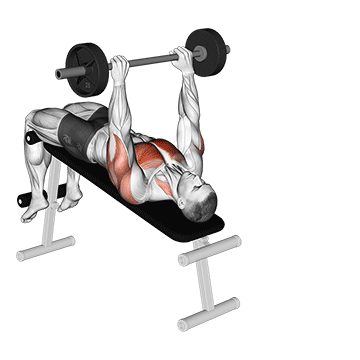
To perform the barbell decline pullover, follow these steps:
1. Start by setting up your decline bench at an angle of about 30 to 45 degrees.
2. Lie down on the bench with your feet securely hooked under the foot pads. Your head should be at the lower end of the bench.
3. Hold a barbell with a medium overhand (palms facing away from you) grip. Extend your arms fully and hold the barbell directly above your chest. This is your starting position.
4. Keeping your arms straight, slowly lower the barbell in an arc behind your head. You should feel a stretch in your chest and rib cage.
5. Pause for a moment when the barbell is about level with your head, then slowly raise it back to the starting position in the same arcing motion.
6. Keep the movement controlled, focusing on the stretch and contraction of the chest muscles.
7. Repeat for the desired number of repetitions.
Remember to keep your arms straight and your movements smooth throughout the exercise. Avoid using your hips or shoulders to lift the weight, and make sure to keep your back flat against the bench. Always use a weight that is challenging but allows you to maintain good form.
barbell decline bench press
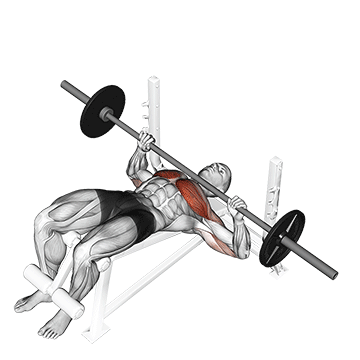
1. Start by setting up your decline bench at an angle of about 15-30 degrees.
2. Load your desired weight onto the barbell and place it on the rack above the decline bench. Ensure the weight is evenly distributed on both sides of the barbell.
3. Position yourself on the decline bench with your feet securely locked under the foot pads. Your head, shoulders, and buttocks should be firmly placed on the bench.
4. Reach up and grasp the barbell with an overhand grip. Your hands should be slightly wider than shoulder-width apart.
5. Carefully lift the barbell off the rack and hold it straight over your chest with your arms fully extended. This is your starting position.
6. Slowly lower the barbell towards your chest while keeping your elbows at a 90-degree angle. Ensure your wrists remain straight and your back stays flat on the bench.
7. Once the barbell is an inch or two from your chest, push it back up to the starting position. Make sure to exhale as you push the barbell up.
8. Repeat this movement for your desired number of repetitions.
9. When you're done, carefully re-rack the barbell. Always ensure safety by having a spotter assist you, especially when lifting heavier weights.
Remember, the key to this exercise is control. Don't rush the movements, and focus on the contraction and stretch of your pecs.
barbell bench press
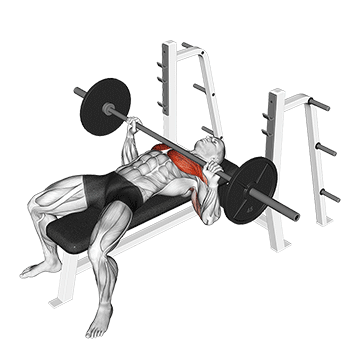
To perform the barbell bench press, start by lying flat on your back on a bench. Your feet should be flat on the floor. Grab the barbell with a grip slightly wider than shoulder-width apart. Lift the barbell off the rack and hold it straight over your chest with your arms fully extended. This is your starting position.
Inhale and slowly lower the barbell until it touches your middle chest. Keep your elbows at a 90-degree angle. Do not let your elbows flare out to the sides. Keep your back flat on the bench.
After a brief pause, push the bar back to the starting position as you exhale. Focus on pushing the bar using your chest muscles. Lock your arms and squeeze your chest in the contracted position at the top of the motion, hold for a second and then start coming down slowly again.
Repeat the movement for the prescribed amount of repetitions. When you are done, place the bar back in the rack.
Ensure that - throughout the movement - your arms move perpendicular to your body. The barbell should be in line with your nipples during the lower part of the movement, and your wrists should be directly above your elbows.
Remember to always use a spotter for safety when performing the barbell bench press.
No tags for this post.
